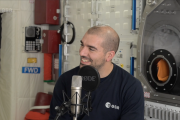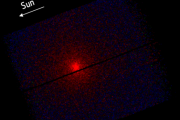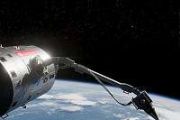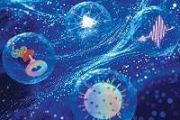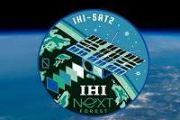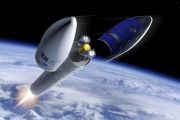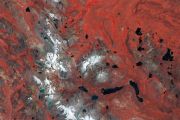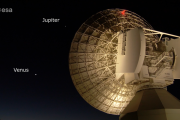
Copernical Team
Cyborg collaboration finds 40,000 ring galaxies
 Human and machine intelligence worked together to find 40,000 ring galaxies, scientists at the National Astronomy Meeting will announce this week. Dr Mike Walmsley of the University of Manchester and the Galaxy Zoo collaboration will present the new work, describing how this "cyborg" approach measured the shapes of millions of galaxies.
Galaxies live a chaotic life. Collisions with other g
Human and machine intelligence worked together to find 40,000 ring galaxies, scientists at the National Astronomy Meeting will announce this week. Dr Mike Walmsley of the University of Manchester and the Galaxy Zoo collaboration will present the new work, describing how this "cyborg" approach measured the shapes of millions of galaxies.
Galaxies live a chaotic life. Collisions with other g Rocking shadows in protoplanetary discs
 Astronomers from the University of Warwick reveal a new phenomenon dubbed the "rocking shadow" effect that describes how discs in forming planetary systems are oriented, and how they move around their host star. The effect also gives clues as to how they might evolve with time. Dr Rebecca Nealon presented the new work this week at the 2022 National Astronomy Meeting at the University of Warwick.
Astronomers from the University of Warwick reveal a new phenomenon dubbed the "rocking shadow" effect that describes how discs in forming planetary systems are oriented, and how they move around their host star. The effect also gives clues as to how they might evolve with time. Dr Rebecca Nealon presented the new work this week at the 2022 National Astronomy Meeting at the University of Warwick. A Rover-Sized Boulder Sols 3532-3533
 Curiosity is back on the road, but some interesting boulders caught our attention and led to a short detour. The team was already planning to divert to the southwest to get some imaging of nearby cliffs, but the large boulders that have tumbled down provide a tantalizing glimpse of what's to come.
Boulders like the large one shown in the above Navcam image (now named "Ilha Novo Destino") c
Curiosity is back on the road, but some interesting boulders caught our attention and led to a short detour. The team was already planning to divert to the southwest to get some imaging of nearby cliffs, but the large boulders that have tumbled down provide a tantalizing glimpse of what's to come.
Boulders like the large one shown in the above Navcam image (now named "Ilha Novo Destino") c Ingenuity Postpones Flights Until August
 It's now dust season and winter on Mars, meaning there's more dust in the air and less sunlight to help recharge Ingenuity's batteries. Dust levels are expected to subside later in July, so the team has decided to give the helicopter's batteries a break for a few weeks and build their daily state of charge back up. Weather permitting, Ingenuity is expected to be back in the air around the start
It's now dust season and winter on Mars, meaning there's more dust in the air and less sunlight to help recharge Ingenuity's batteries. Dust levels are expected to subside later in July, so the team has decided to give the helicopter's batteries a break for a few weeks and build their daily state of charge back up. Weather permitting, Ingenuity is expected to be back in the air around the start Dragon docks at ISS to deliver various science payloads
 While the International Space Station was traveling more than 267 miles over the South Atlantic Ocean, the SpaceX Dragon cargo spacecraft autonomously docked to the forward-facing port of the station's Harmony module at 11:21 a.m. EDT Jul 17, with NASA astronauts Bob Hines and Jessica Watkins monitoring operations from the station.
The Dragon launched on SpaceX's 25th contracted commercial
While the International Space Station was traveling more than 267 miles over the South Atlantic Ocean, the SpaceX Dragon cargo spacecraft autonomously docked to the forward-facing port of the station's Harmony module at 11:21 a.m. EDT Jul 17, with NASA astronauts Bob Hines and Jessica Watkins monitoring operations from the station.
The Dragon launched on SpaceX's 25th contracted commercial NASA, Northrop Grumman to test fire future Artemis booster motor
 NASA and Northrop Grumman will perform a full-scale static test of a Space Launch System (SLS) solid rocket booster motor at Northrop Grumman's Promontory, Utah, test facility July 21. Engineers will fire the booster during the demonstration, called the Flight Support Booster 2 test, to evaluate materials and processes to improve boosters for future Artemis missions.
"The current SLS boost
NASA and Northrop Grumman will perform a full-scale static test of a Space Launch System (SLS) solid rocket booster motor at Northrop Grumman's Promontory, Utah, test facility July 21. Engineers will fire the booster during the demonstration, called the Flight Support Booster 2 test, to evaluate materials and processes to improve boosters for future Artemis missions.
"The current SLS boost US, Russian astronauts will swap seats on rockets again

A little piece of Washington state blasted into space this week

A tiny piece of rural Washington state—and some of its "inhabitants"— blasted off into space from Kennedy Space Center in Florida on Thursday, July 14.
The inhabitants are bacteria that live in the soil in Prosser, Wash. Scientists will study what the bacteria do in a microgravity environment to learn more about how soil microbial communities function in space. That's information scientists need to grow food either in space or on another celestial body.
The experiment, funded by NASA, is called DynaMoS, or Dynamics of Microbiomes in Space. The study is being conducted by researchers at the Department of Energy's Pacific Northwest National Laboratory.
US renews space flights with Russia in rare cooperation
 The United States and Russia said Friday they would renew flights together to the International Space Station, preserving one of the last areas of cooperation amid Western attempts to isolate Moscow over the invasion of Ukraine.
"To ensure continued safe operations of the International Space Station, protect the lives of astronauts and ensure continuous US presence in space, NASA will resume
The United States and Russia said Friday they would renew flights together to the International Space Station, preserving one of the last areas of cooperation amid Western attempts to isolate Moscow over the invasion of Ukraine.
"To ensure continued safe operations of the International Space Station, protect the lives of astronauts and ensure continuous US presence in space, NASA will resume Russian space chief Rogozin to get new job: Kremlin
 The head of Russia's space agency, who has made headlines with his bombastic statements and support for Moscow's Ukraine offensive, has been relieved of his duties and will get a new job, the Kremlin said Friday.
Dmitry Rogozin, a firebrand nationalist politician and one of the most ardent supporters of Moscow's offensive in Ukraine, was dismissed as head of Roscosmos, a Kremlin decree said.
The head of Russia's space agency, who has made headlines with his bombastic statements and support for Moscow's Ukraine offensive, has been relieved of his duties and will get a new job, the Kremlin said Friday.
Dmitry Rogozin, a firebrand nationalist politician and one of the most ardent supporters of Moscow's offensive in Ukraine, was dismissed as head of Roscosmos, a Kremlin decree said. 





